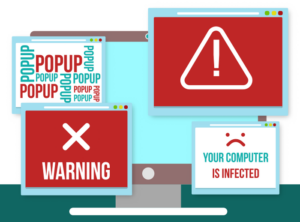Your WordPress website is a valuable asset for your business, but it’s also a prime target for hackers looking for vulnerabilities. A hack can lead to severe consequences, such as data loss, decreased website performance, and even legal action. So how do you know if your website has been hacked? And if it has, what can you do to fix the issue? In this article, we’ll cover the signs of a hacked website and the steps you can take to secure it.

Signs of a Hacked Website:
1. The WordPress site redirects to another URL
WordPress website redirects to spam links is a common problem that can occur when a website has been hacked. This can happen when a hacker gains access to the site’s code and alters the settings to redirect users to a different website.
2. Unable to log in to WordPress
Unable to log in to your WordPress website can signify that your website has been hacked. Hackers often try to access the website’s admin area by guessing or brute-forcing login credentials. Once they have access, they can change the website’s settings, install malware or redirect visitors to another website. Suppose you cannot log in to your website. In that case, it’s essential to check for any suspicious activity in your website’s log files, remove any unauthorized users, and remove any suspicious files or folders.
3. Suspicious user accounts in WordPress
Discovering suspicious user accounts on your WordPress website signifies that your website may have been hacked. Hackers often create new user accounts to gain access to the website’s admin area or to use the website for their purposes, such as spamming or phishing. If you notice any suspicious user accounts, you must immediately remove the accounts and change your login credentials.
4. Defacement content
Discovering defacement content on your WordPress website is a sign that your website has been hacked. Defacement content refers to unauthorized changes to your website’s content, such as text, images, or videos. Hackers often use this tactic to spread their message, promote their brand, or redirect visitors to a different website.
5. Bad Links added to your website
Discovering bad links added to your website is a sign that your website has been hacked. These links could be directed to malicious or phishing websites that can harm your website’s reputation and can put your visitors at risk. Hackers often use this tactic to spread malware or steal personal information from visitors.
6. A sudden drop in website traffic
A sudden drop in website traffic can signify that your WordPress website has been hacked. Hackers often use various tactics to disrupt a website’s performance and redirect visitors to another website, resulting in traffic loss. Additionally, a drop in traffic can also be caused by search engines penalizing a website for hosting malicious content or links, which can cause the website to be removed from search engine results.
7. Unknown files and scripts
Discovering unknown files and scripts on your WordPress website signifies that your website may have been hacked. Hackers often use these files to gain access to your website, steal sensitive information, or launch a malicious attack. These files can be challenging to spot as they often have obscure names and can be hidden in various directories of your website.
8. Hijacked search results
Discovering that your website’s search results have been hijacked is a sign that your website may have been hacked. Hackers often use this tactic to redirect visitors to a different website or display malicious content. This can not only damage your website’s reputation and credibility, but it can also put your visitors at risk.
9. Unresponsive and slow website
An unresponsive or slow website can signify that your WordPress website has been hacked. Hackers often use various tactics to disrupt a website’s performance, such as injecting malicious code or using a DDoS attack. These actions can overload the server and cause the website to become unresponsive or slow. Additionally, a slow website can also be caused by malware or malicious scripts that are running on the website.
10. Unknown server log
Discovering unknown server logs on your WordPress website signifies that your website may have been hacked. Hackers often use these logs to track their activity on the website and gain access to sensitive information. These logs can also indicate malicious code or scripts installed on the website.
If you notice any of these signs, securing your website immediately is important.
Steps to Take:
- Change all your passwords: This includes your website’s admin password, FTP, and hosting account passwords.
- Scan your website for malware: Use a security plugin or online scanner to check for malware and remove it.
- Check your website’s log files: Look for suspicious activity and remove unauthorized users.
- Remove any suspicious files or folders: Delete any files or folders you don’t recognize.
- Keep your website updated: Make sure that your website’s software, themes, and plugins are up-to-date.
- Get professional help: If you’re unsure how to fix the issue, consider hiring a professional WordPress security expert to help secure your website.
Following these steps, you can secure your WordPress website and protect it from hackers. Remember that website security is ongoing, so it’s important to stay vigilant and keep your website updated and protected.
In conclusion, being aware of the signs of a hacked website and taking the proper steps to fix the issue is crucial to securing and protecting your website from hackers. It’s essential to regularly check for suspicious activity, update your website, and get professional help. With the proper steps, you can keep your website secure and protect your business from threats.